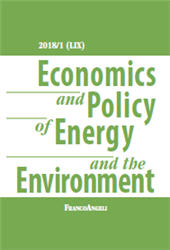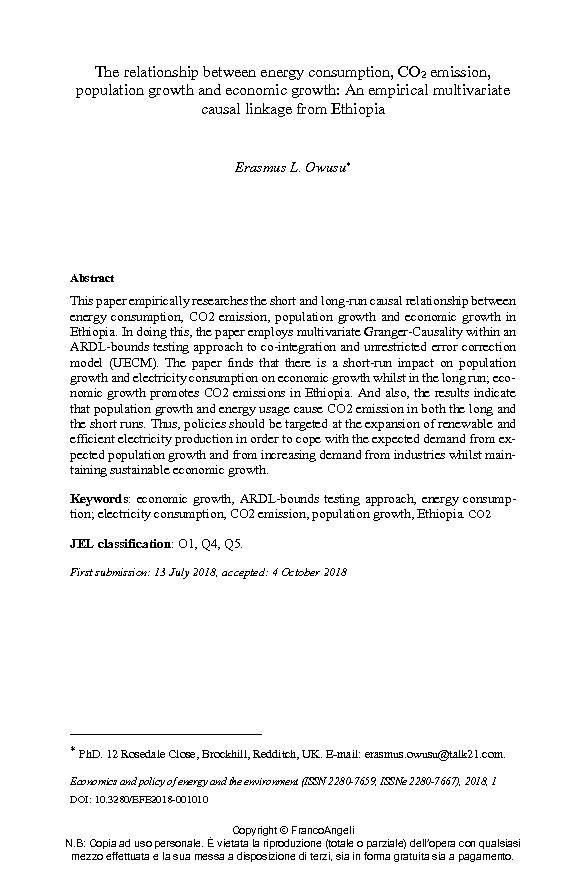The relationship between energy consumption, CO2 emission, population growth and economic growth : an empirical multivariate causal linkage from Ethiopia
225-239 p.
This paper empirically researches the short and long-run causal relationship be-tween energy consumption, CO2 emission, population growth and economic growth in Ethiopia. In doing this, the paper employs multivariate Granger-Causality within an ARDL-bounds testing approach to co-integration and unre-stricted error correction model (UECM). The paper finds that there is a short-run impact on population growth and electricity consumption on economic growth whilst in the long run; economic growth promotes CO2 emissions in Ethiopia. And also, the results indicate that population growth and energy usage cause CO2 emis-sion in both the long and the short runs. Thus, policies should be targeted at the expansion of renewable and efficient electricity production in order to cope with the expected demand from expected population growth and from increasing de-mand from industries whilst maintaining sustainable economic growth.
This paper aimed to identify the most pressing concerns in attaining financing readiness for climate compatible development in Cagayan de Oro City, a second-tier city in the Philippines. It employed a participatory methodology that incorporated local expertise, stakeholders' experiences and perceptions, preconditions for ensuring an effective design of climate change compatible development measures in Cagayan de Oro City. Specifically, it adopted the science-based stakeholder (SBS) method involving all relevant stakeholders throughout the stages of the research. Despite the existence of strategic plans, existing policy measures and financing schemes to address climate change compatible development in the city, the existing gaps between the types of projects needed by the city and the ability to access funds resulted to a limited or lack of implementation of these plans and improvement of the existing measures.
At the local government level, there are several constraints in financing a more programmatic climate change compatible development in the city. Nonetheless, there are new emerging initiatives by government agencies, non-government and private institutions in the city that are currently being promoted In this paper we revisit the research question of how Indian economy reacted to the changes in the historical oil price. Data on aggregate variables such as real GDP, WPI, interest rate and money supply since 1996 to 2017 are used to estimate Auto-Regressive Distributed Lag (ARDL) model and Structural Vector Auto-Regressive model (SVAR). Empirical results clearly show that oil price is negatively related to real GDP and at the same time, its effect on general inflation is not clear probably due to the massive subsidization of energy resources during the period of study and consequent cushioning of the inflationary effect of oil price shock.
Results also show that in the short run, macroeconomic aggregates are mostly influenced by real factors than monetary factors. Result implies that policy makers must create adequate safeguards to ensure that ordinary citizens are not hurt from oil shock as India's reliance on oil import is expected to increase in the future and also promote efficient use of energy resources. Does an efficient and flexible mechanism exist to address negative externalities of products, or are we doomed to grow the list of product standards? In this paper, I open the discussion whether eco-modulation in the framework of collective extended producer responsibility (EPR) could be able to spur the design of more environmentally sound products at end of life. In Europe, EPR for final products has mainly been implemented in the form of collective systems, where producers pay a fee per quantity of items placed on the market to a central organisation. This compliance fee represents the average cost of treating waste for a given
Since waste management costs are averaged across producers, such collective EPR schemes have been criticised for hindering individual internalisation of products' end-of-life externalities. To deal with these critiques, French public authorities have imposedeco-modulation to EPR collective systems. Eco-modulation consists in penalising or rewarding individual design choices of producers, using financial incentives. The European Commission is now planning to revise its directive Dir. 1994/62/EC to provide guiding principles on eco-modulation for packaging for all EPR organisations across Europe. In general, eco-modulation is becoming increasingly relevant on the European scene. Therefore, I aim at reflecting on the efficiency of eco-modulation in addressing products' negative externalities at end-of-life, by analysing early feedbacks and data from French EPR systems.
Asian economies are often characterized as having bank-dominated financial systems and underdeveloped capital markets, in particular with regard to venture capital. In economies that banks are the main source of funding, the main obstacle for financing infrastructural projects including renewable energy (RE) projects is lack of access to long-term finance. The second obstacle for development of RE energy projects is their lower rate of return comparing to fossil fuel projects as more subsidies are globally going to fossil fuels. For larger RE projects insurance and pensions are sustainable financing alternatives. Pension funds and insurance companies hold long-term savings, so these institutions could be a proper alternative for financing mega-size RE projects. In addition, utilizing the spillover effects originally created by energy supplies in form of tax revenues refund to RE projects will increase their rate of return and make them interesting for private investors.
For smaller-size RE projects, the paper provides a theoretical model for combining utilisation of carbon tax and a new way of financing risky capital, i.e., Hometown Investment Trust Funds (HITs). The paper theoretically shows that by environmental taxation and allocating these tax revenues to HITs, RE projects will become more feasible and more interesting for private investors; hence the supply of investment money to these funds will increase. Greenhouse gases (GHG) emissions are rising worldwide. Despite the efforts made both at the national and at the international level, new policies are needed in order to effectively reduce the GHG emissions. Command-and-control policies have been frequently adopted, but proved not to suffice to reverse the phenomenon. A carbon tax could make the case, but it is seldom implemented due to its assumed political unpopularity. A contingent valuation experiment is performed in USA and in Italy to analyze this issue.
The results show that the policy acceptability is very high and that the median WTP ranges between a minimum of 161 and a maximum of 246, and varies according to the tax revenue use, the respondents' nationality, the respondents' beliefs and knowledge about climate change, and some sociodemographic characteristics. Policy implications of the results obtained are further described in the paper. Termed a "climate-energy contribution", the carbon tax was introduced in France in 2014 to price energy-related CO2 emissions not covered by the European emissions trading scheme. Its ramp-up is likely to accelerate, at least as far as the rate is concerned, calling for an initial assessment of its actual effects.
Such an evaluation is what this edition of Information & Debates provides, concentrating on the sectors most concerned. Evaluating the impact of the tax is not just a matter of comparing emissions before and after the tax came into force, but requires a comparison of the emissions observed over the period with the evolution of a "counterfactual" scenario representing the hypothetical trajectory that emissions would have followed in its absence. In the first part, we look at the contextual elements needed to understand how the price signal of carbon affects economic actors by way of energy prices. In the second and third parts we then evaluate the impacts of the tax by taking an ex ante approach and an ex post approach respectively. The ex-ante approach is based on calculating price and tax elasticities. It is carried out indi-rectly by comparing the carbon tax with an increase in the prices of fossil fuels.
Although this raises the question of transmission from the one to the other, it has the advantage of not requiring a temporal distance in relation to the introduction of the tax. The results suggest that the carbon tax led to a reduction in emissions from the transport sector of between 0.6 and 1.7 Mt of CO2 in 2017. Taxation of heating oil for its part reduced emissions from the heating of buildings by 0.7 Mt CO2. For transport and fuel oil, the method leads to the prediction that by the end of the five-year period the tax should lead to a reduction in emissions of between 3 and 5.7 Mt of CO2 compared to 2017. These various estimates likely to be a minimum, since it seems that consumers are more responsive to a price increase resulting from higher taxes than to one induced by a change in the price of fossil raw materials. The ex post approach is based on the "synthetic control" method, and involves reconstructing France's hypothetical emissions from a group of comparable countries that have not introduced
This approach produces a direct evaluation in that the impact of the tax is estimated is implemented over the period the tax has been in force. Applied to France over the period 2014-2017, it does not allow a robust conclusion to be drawn as to the impact of the introduction of the carbon tax on emissions from the transport or building heating sector over the period concerned. This result may be explained by the small number of observations currently available since the introduction of the tax. The use of economic instruments in environmental policies has attracted a wide and increasing interest in the international and European debate in recent decades. Environmental taxes and subsidies, in particular, have been seen as useful policy instruments to enhance environmental protection, getting the price right and creating market based incentives for environmentally-friendly behaviors. Despite these premises, the actual implementation of EFRs has often lagged behind their full potential, leading to marginal
In this paper we describe the main characteristics of, respectively, environmentally related taxes and environmentally related subsidies at present implemented in Italy, designing some possible evolutionary paths, both on the revenue and expenditure side. The Italian experience turns out to be, in this perspective, an interesting case study, for several reasons. Firstly, because both taxes and subsidies have, in the past, been largely exploited for the attainment of wider economic and social objectives, often without a full ex-ante and ex-post assessment of their level of environmental merit. Secondly, because the recent economic crises exacerbated the need for high-debt countries to find growth-friendly and less distortive ways to correct budget imbalances, reforming and optimizing both the revenue and the expenditure side of the public intervention.
Thirdly, because many international organizations and scientific agencies have recommended that Italy develop its environmental fiscal reform, with the indispensable steps of introducing new green taxes, restructuring existing ones and removing environmentally-harmful subsidies. All in all, the analysis leads to the conclusion that the key objective should be that of selectivity: i.e. that of tackling environmental challenges in an effective way, aligning taxes to closer reflect environmental damage, benefits and priorities, and without having revenue-generating potential as the first driving force of future initiatives. [Publisher's text]
Fait partie de
Economics and Policy of Energy and Environment : 1, 2018-
Articles du même numéro (disponibles individuellement)
-
Informations
Code DOI : 10.3280/EFE2018-001010
ISSN: 2280-7667
DISCIPLINES
KEYWORDS
- Economic growth, ARDL-bounds testing approach, energy consump-tion, electricity consumption, CO2 emission, population growth, Ethiopia CO2.



